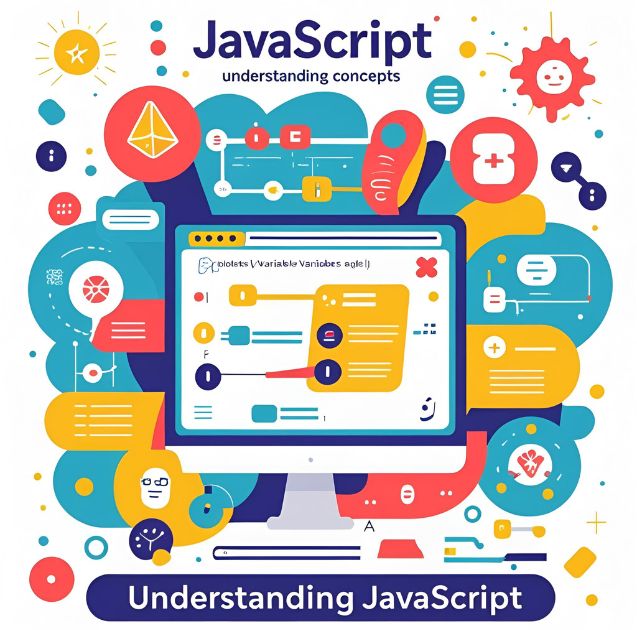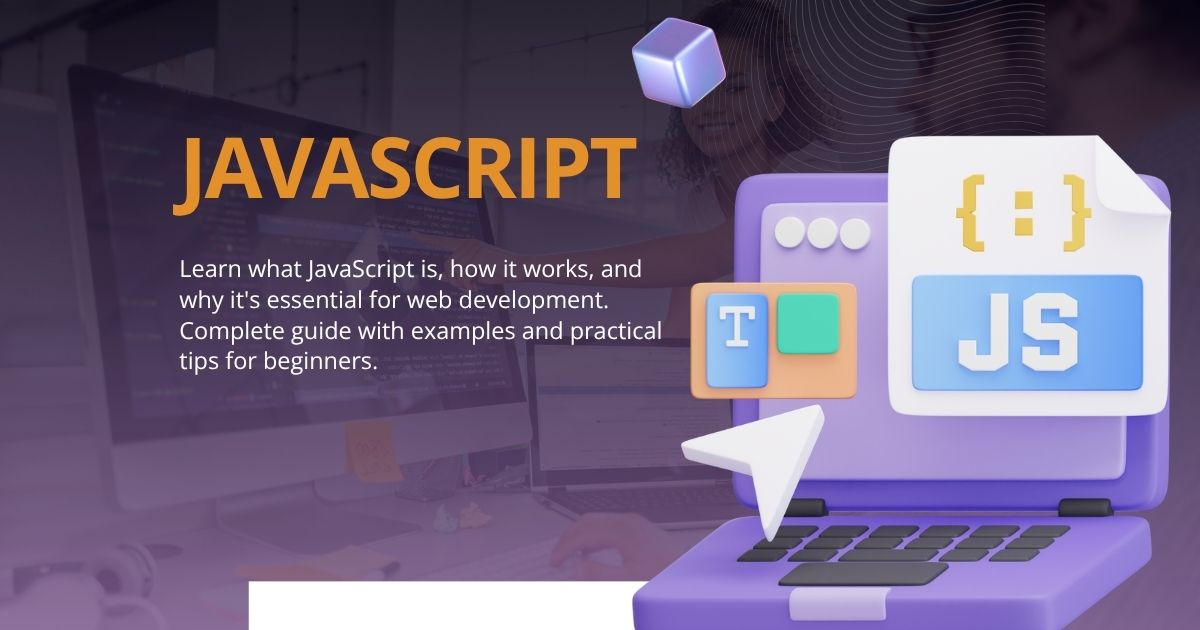JavaScript powers nearly every website you visit. From the moment you click a button to the instant a page loads new content, JavaScript is working behind the scenes to make your web experience smooth and interactive.
But what exactly is JavaScript? How does it work, and why has it become such a fundamental part of web development? This guide will break down everything you need to know about JavaScript, from its basic concepts to its real-world applications.
Understanding JavaScript: The Basics

JavaScript is a programming language that brings websites to life. While HTML creates the structure of a webpage and CSS handles the styling, JavaScript adds the interactive elements that make modern websites engaging and functional.
Unlike many programming languages that require compilation before running, JavaScript is an interpreted language. This means it runs directly in your web browser without any additional setup or compilation steps.
How JavaScript Differs from Other Languages
JavaScript stands out from other programming languages in several key ways:
Client-side execution: JavaScript runs in the user’s browser, not on the server. This allows for immediate responses to user actions without waiting for server communication.
Dynamic typing: You don’t need to declare variable types in JavaScript. The language automatically determines whether a variable contains text, numbers, or other data types.
Event-driven programming: JavaScript responds to user interactions like clicks, form submissions, and mouse movements through event handlers.
Prototype-based: Instead of traditional class-based inheritance, JavaScript uses prototypes to create and extend objects.
The History and Evolution of JavaScript
JavaScript was created in 1995 by Brendan Eich at Netscape Communications. Despite its name, JavaScript has no direct relationship to the Java programming language. The naming choice was primarily a marketing decision during Java’s peak popularity.
The language has evolved significantly since its creation:
1995-1997: Initial development and standardization efforts began
1999: ECMAScript 3 introduced regular expressions and better error handling
2009: ECMAScript 5 added strict mode and new array methods
2015: ECMAScript 6 (ES6) brought major improvements, including arrow functions, classes, and modules
2016-Present: Annual releases continue to add new features and improvements
Core JavaScript Concepts
Variables and Data Types
JavaScript uses variables to store information. You can create variables using let, const, or var keywords:
let userName = "John"; const age = 25; var isActive = true;
The language supports several data types:
- Strings: Text values like “Hello World”
- Numbers: Both integers and decimals, like 42 or 3.14
- Booleans: True or false values
- Arrays: Lists of values like [1, 2, 3]
- Objects: Collections of key-value pairs
Functions
Functions are reusable blocks of code that perform specific tasks. They’re fundamental to JavaScript programming:
function greetUser(name) {
return "Hello, " + name + "!";
}
Control Structures
JavaScript uses familiar programming constructs like loops and conditional statements:
if (age >= 18) {
console.log("You can vote!");
} else {
console.log("Too young to vote.");
}
Where JavaScript Runs
Web Browsers
JavaScript’s primary environment is the web browser. Every modern browser includes a JavaScript engine that executes code:
- Chrome: V8 engine
- Firefox: SpiderMonkey
- Safari: JavaScriptCore
- Edge: Chakra (legacy) or V8 (Chromium-based)
Server-Side with Node.js
Node.js allows JavaScript to run on servers, enabling full-stack JavaScript development. This means you can use the same language for both frontend and backend development.
Mobile Applications
Frameworks like React Native and Ionic allow developers to create mobile apps using JavaScript, sharing code between iOS and Android platforms.
JavaScript in Action: Common Use Cases
Interactive Web Elements
JavaScript powers the interactive elements you encounter daily:
- Form validation: Checking if email addresses are valid before submission
- Dynamic content: Loading new posts on social media feeds without page refreshes
- Image galleries: Creating slideshow effects and lightboxes
- Navigation menus: Dropdown menus and mobile hamburger menus
Web Applications
Modern web applications rely heavily on JavaScript:
- Gmail: Uses JavaScript for real-time email loading and composition
- Google Maps: Interactive mapping and location services
- Netflix: Video streaming controls and recommendation systems
- Online banking: Secure transaction processing and account management
Game Development
JavaScript can create browser-based games ranging from simple puzzles to complex multiplayer experiences. The HTML5 Canvas API and WebGL enable sophisticated graphics and animations.
JavaScript Frameworks and Libraries
The JavaScript ecosystem includes numerous frameworks and libraries that simplify development:
Frontend Frameworks
React: Developed by Facebook, React focuses on building user interfaces through reusable components.
Angular: A comprehensive framework by Google that provides a complete solution for building web applications.
Vue.js: Known for its gentle learning curve and progressive adoption approach.
Backend Frameworks
Express.js: A minimal web framework for Node.js applications.
Next.js: A React-based framework that enables server-side rendering and static site generation.
Getting Started with JavaScript
Setting Up Your Development Environment
You don’t need expensive software to start learning JavaScript. Here’s what you need:
- Text Editor: VS Code, Sublime Text, or even Notepad will work
- Web Browser: Any modern browser with developer tools
- Optional: Node.js for server-side development
Your First JavaScript Program
Create an HTML file and add this code:
<!DOCTYPE html>
<html>
<head>
<title>My First JavaScript</title>
</head>
<body>
<h1>Hello, JavaScript!</h1>
<script>
alert("Welcome to JavaScript!");
</script>
</body>
</html>
Learning Resources
Online Courses: Platforms like Codecademy, freeCodeCamp, and MDN Web Docs offer comprehensive JavaScript tutorials.
Practice Platforms: Sites like LeetCode, HackerRank, and CodeWars provide coding challenges to strengthen your skills.
Books: The “You Don’t Know JS” series and “JavaScript: The Good Parts” are excellent resources for deeper understanding.
JavaScript Best Practices

Code Organization
Keep your code organized with proper naming conventions and structure:
// Use descriptive variable names
const userAccountBalance = 1000;
// Group related functions together
const userActions = {
login: function() { /* login logic */ },
logout: function() { /* logout logic */ }
};
Performance Considerations
- Minimize DOM manipulation: Batch updates to reduce browser reflows
- Use event delegation: Handle events efficiently for dynamic content
- Optimize loops: Choose the right loop type for your specific use case
- Cache frequently accessed elements: Store DOM references in variables
Security Awareness
JavaScript security is crucial for protecting users and applications:
- Validate user input: Never trust data from external sources
- Use HTTPS: Ensure secure data transmission
- Implement Content Security Policy: Prevent cross-site scripting attacks
- Keep dependencies updated: Regularly update libraries and frameworks
The Future of JavaScript
JavaScript continues to evolve with new features and capabilities:
Emerging Technologies
WebAssembly: Enables near-native performance for web applications by running compiled code alongside JavaScript.
Progressive Web Apps: JavaScript-powered applications that work offline and provide app-like experiences.
Machine Learning: Libraries like TensorFlow.js bring AI capabilities to browsers and Node.js applications.
Language Evolution
The ECMAScript committee continues to add new features annually, making JavaScript more powerful and developer-friendly. Recent additions include optional chaining, nullish coalescing, and top-level await.
Taking Your Next Steps with JavaScript
JavaScript opens doors to countless opportunities in web development, mobile applications, and even desktop software. The language’s versatility and extensive ecosystem make it an excellent choice for both beginners and experienced developers.
Start with the basics: variables, functions, and control structures. Practice regularly by building small projects like calculators, to-do lists, or simple games. As you become more comfortable, explore frameworks and libraries that align with your interests.
Remember that mastering JavaScript is a journey, not a destination. The language and its ecosystem constantly evolve, providing endless opportunities for learning and growth. Whether you’re building your first website or developing complex applications, JavaScript provides the tools and flexibility to bring your ideas to life.







